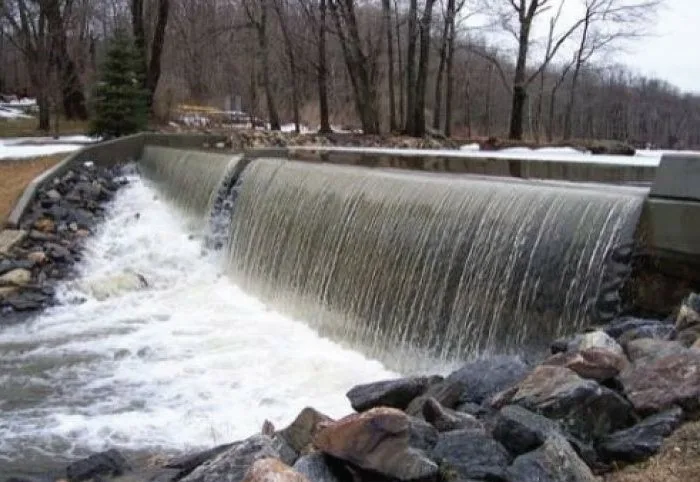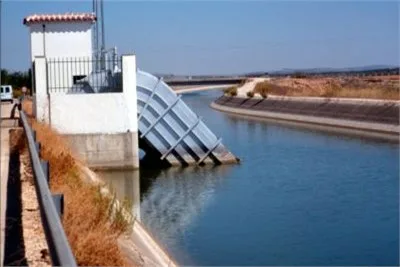A spillway is structure built in dams designed to release surplus water safely and avert the risk of the dam overtopping and potential failure. They are typically constructed using reinforced concrete, steel, and masonry, either as integral parts of the main dam or as separate structures. Their primary function is to provide a controlled mechanism for discharging water, particularly during intense rainfall or snowmelt. This controlled release helps to regulate water levels in the reservoir and maintain dam stability.
Why Spillways are used in Dams?
- Allow controlled water release when reservoir levels reach a specific point.
- By diverting floodwaters, spillways protect dams from inundation.
- Helps in regulating water levels within the reservoir.
- Dissipate water speed, preventing downstream scouring and erosion.
- Controlled sediment release prevents reservoir sedimentation.
Structural parts of Spillway Construction
- Approach Channel: Guides incoming water toward the spillway.
- Control Structure: Manages water release for controlled discharge.
- Discharge Carrier: Efficiently transports water, preventing backflow.
- Discharge Channel: Guides released water away to minimise erosion.
- Energy Dissipators: Placed downstream to dissipate excess energy.
Location of Spillway in Dams



Factors Affecting Capacity of Spillway Construction in Dams
- Inflow Rate Analysis
- Reservoir Storage Capacity
- Outlet Capacity
- Gate Design and Capacity
- Damage Evaluation
Different types of spillways used in dams
Straight Drop Spillway:
A Straight Drop Spillway is a hydraulic structure designed to efficiently channel excess water from a reservoir. This spillway features a straightforward design, where water descends vertically over a concrete or reinforced structure. The primary goal is to rapidly release water without introducing significant changes in direction, minimising turbulence and erosion. While simple in concept, the Straight Drop Spillway is effective in preventing reservoir overflow and ensuring controlled discharge.

Ogee Spillway:
The Ogee Spillway is an engineered structure with a distinctive S-shaped curve. This design is carefully crafted to optimise the control and regulation of water flow. The smooth curve of the ogee helps distribute the force of the water, reducing the potential for erosion downstream. Ogee spillways are commonly employed in dams and reservoirs where precision in managing water discharge is important. The elegant form of the spillway serves both functional and aesthetic purposes, combining efficiency with a visually pleasing design.

Chute Spillway:
A Chute Spillway employs a steep, sloping channel to guide excess water from a higher elevation to a lower one. The chute, often constructed from concrete, regulates the flow of water as it descends. This type of spillway is particularly useful in situations where a rapid and controlled release of water is necessary. Chute spillways are commonly found in dams and other water management structures where the topography allows for the creation of a descending channel.

Side-Channel Spillway:
The Side-Channel Spillway is designed to divert surplus water through a separate channel located alongside the main dam or structure. This alternative route helps alleviate pressure on the primary structure and reduces the risk of overflow. Side-channel spillways are often employed when traditional spillways may not provide sufficient capacity and require a more controlled discharge into a specific area.

Shaft Spillway:
Shaft Spillways utilise a vertical shaft to convey water from a higher elevation to a lower one. This type of spillway is often employed in situations where space constraints or the soil nature limits the feasibility of other spillway designs. The vertical descent of water through a shaft provides a controlled means of releasing water while minimising the impact on the surrounding environment.

Syphon Spillway:
A Syphon Spillway operates on the principle of a syphon to draw water from a higher reservoir to a lower outlet. The syphon effect enables the spillway to maintain a continuous flow without the need for mechanical pumping. Syphon spillways are effective in situations where a natural gravity-driven discharge is desired, and they find application in various water management systems.

Conduit Spillway:
Conduit Spillways utilise conduits or pipes to direct water from a reservoir to a lower elevation. These conduits are designed to control the flow and prevent excessive pressure buildup. This type of spillway is commonly employed in tunnels or pipelines, providing a controlled pathway for water release.
Culvert Spillway:
A Culvert Spillway incorporates a culvert, which is a structure resembling a tunnel or pipe, to carry water beneath an obstacle such as a road or embankment. Culvert spillways are designed to manage water flow in situations where traditional spillway configurations may not be practical. The culvert allows for the controlled passage of water, preventing overflow and potential damage to surrounding structures.

Spillway design; Factors to consider and design methods for construction
Factors Influencing Spillway Design
a. Safety and Cost-Effectiveness Alignment
b. Hydrological and Site Conditions:
- Inflow discharge, its frequency, and hydrograph shape
- Dam height
- Geological and site conditions
- Terrain steepness
- Excavation volume and its potential use in embankment
- Scour possibilities
- Slope stability and soil bearing capacity
- Soil permeability
Design Method for Spillways in Dams
The spillway design involves selecting the type, location, and dimensions that meet required capacity and safety criteria.
1. Design Criteria:
- Design flood
- Allowable headwater elevation
- Freeboard
- Tailwater elevation
- Erosion control measures
2. Consider site topography and reservoir configuration to choose spillway type and location.
3. Detailed hydraulic analysis of flow, velocity, pressure, and energy dissipation.
4. Assessment of water quality, sediment transport and fish passage.
6. Emergency spillway inclusion, in case the primary spillway is insufficient.
7. Analysing optimal capacity-to-dam height ratio.
8. Select spillway type allowing ease of inspection, maintenance, and repairs.
Conclusion
Spillways play an important role in ensuring dam safety and effective water management. The design, efficiency, and maintenance of these structures are important in averting catastrophic failures and ensuring the controlled release of surplus water. In this article, we have focused on various types of spillways and design methods. In an upcoming article, we will delve into each spillway type, exploring their advantages, functions, and applications.



